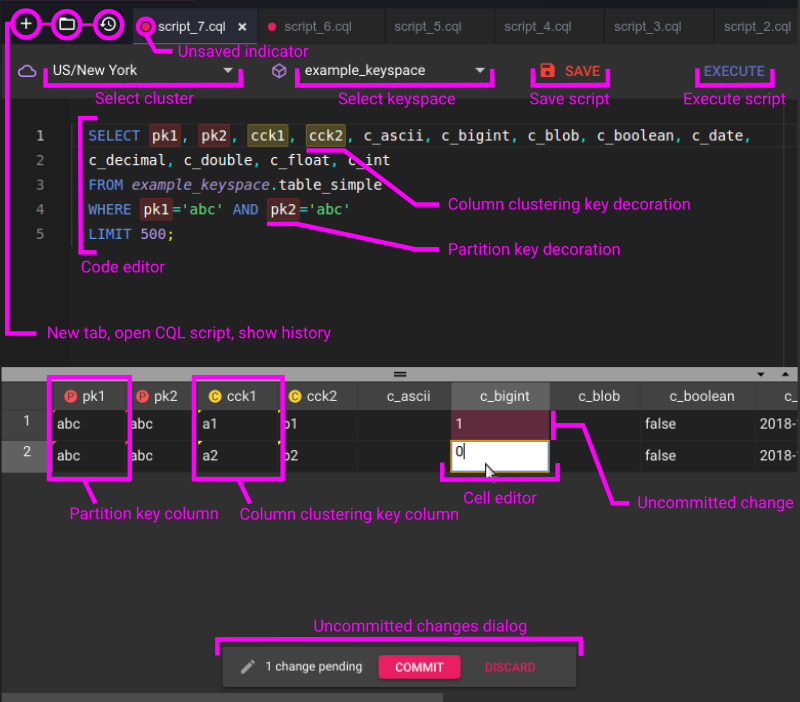CREATE KEYSPACE temperature
WITH replication =
{'class': 'SimpleTopologyStrategy', 'replication_factor':'2'};Introduction to Apache Cassandra
Andrei Arion, LesFurets.com, tp-bigdata@lesfurets.com
Plan
Motivation
Apache Cassandra
Partitioning and replication
Consistency
Practice: Tune consistency in Apache Cassandra
Motivation
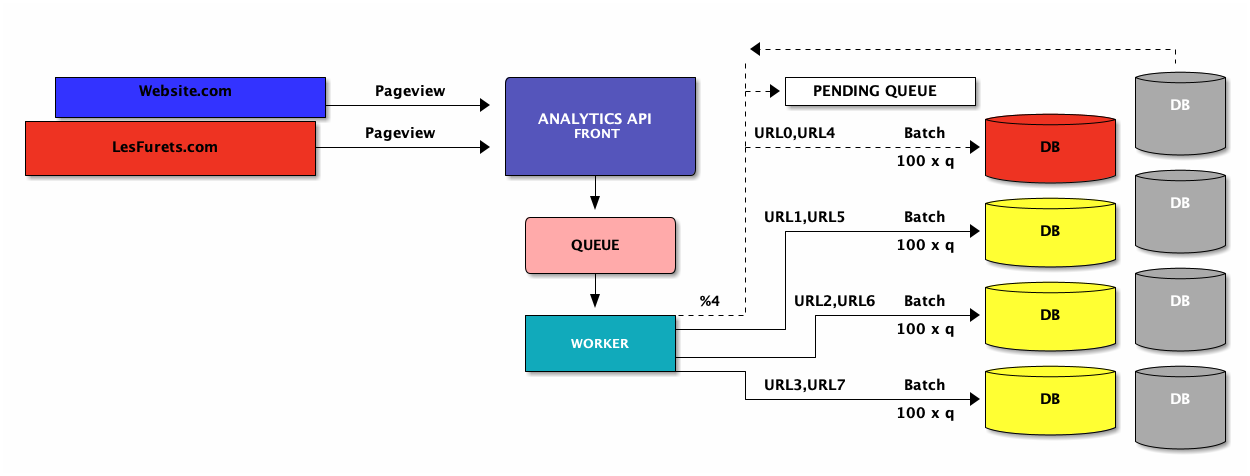
do I build new features for customers?
or just dealing with reading/writting the data?
What went wrong?
A single server cannot take the load ⇒ solution / complexity
Better database
easy to add/remove nodes (scalling)
transparent data distribution (auto-sharding)
handle failures (auto-replication)
Plan
Motivation
Apache Cassandra
Partitioning and replication
Consistency
Practice: Tune consistency in Apache Cassandra
Apache Cassandra
started @Facebook inspired by BigTable model and Amazon DynamoDB
2008 Open Source Project
Datastax: commercial offering Datastax Enterprise
monitoring(OpsCenter) automating repairs backup…
other features: search, analytics, graph, encryption
2010 Top Level Apache Project
Datastax biggest committer
Apache Cassandra
Open source, distributed database designed to handle large amounts of data across many commodity servers, providing high availability with no single point of failure. It offers robust support for clusters spanning multiple datacenters, with asynchronous masterless replication allowing low latency operations for all clients.

Apache Cassandra
column oriented NoSQL database
distributed (data, query)
resilient (no SPOF)
we can query any node ⇒ coordinator to dispatch and gather the results
reliable and simple scaling
online load balancing and cluster growth
Apache Cassandra users

source: https://codingjam.it/
Cassandra terminology
| RDBMS | Cassandra |
|---|---|
Schema (set of tables) | Keyspace |
Table | Table/column family |
Row | Row |
Database server | Node |
Master/Slave | Cluster: a set of nodes groupped in one or more datacenters (can span physical locations) |
Cassandra ring
Gossip
peer-to-peer communication protocol
discover and share location and state information about nodes
persist gossip info locally to use when a node restarts
seed nodes ⇒ bootstrapping the gossip process for new nodes joining the cluster
Cassandra replicas
Cassandra node failure
Query
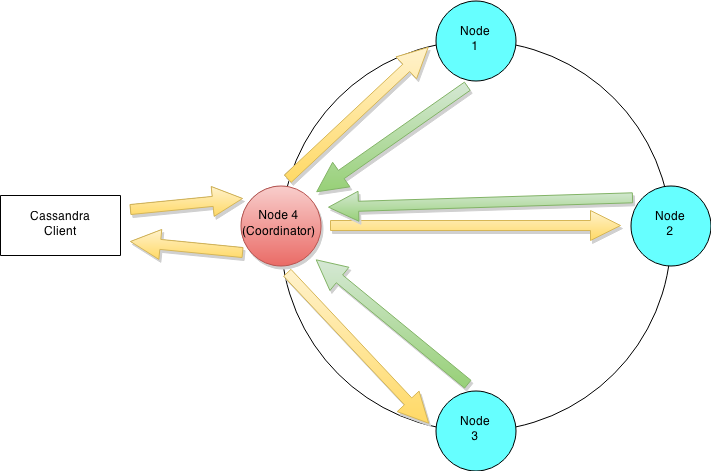
Plan
Motivation
Apache Cassandra
Partitioning and replication
Consistency
Practice: Tune consistency in Apache Cassandra
Cassandra data model
Stores data in tables/column families as rows that have many columns associated to a row key
Map<RowKey, SortedMap<ColumnKey, ColumnValue>>

Data partitioning
C* = single logical database spread across a cluster of nodes
How to divide data evenly around its cluster of nodes?
distribute data efficiently, evenly
determining a node on which a specific piece of data should reside on
minimise the data movements when nodes join or leave the cluster ⇒ Algorithm of Consistent Hashing
Mapping data to nodes
Problem: map k entries to n physical nodes
Naive hashing (NodeID = hash(key) % n) ⇒ remap a large number of keys when nodes join/leave the cluster
Consistent hashing: only k/n keys need to be remapped on average
Consistent Hashing
Idea :
use a part of the data as a partition key
compute a hash value for each
The range of values from a consistent hashing algorithm is a fixed circular space which can be visualised as a ring.
Partitioner
hash function that derives a token from the primary key of a row
determines which node will receive the first replica
RandomPartitioner, Murmur3Partitioner, ByteOrdered
Murmur3Partitionner
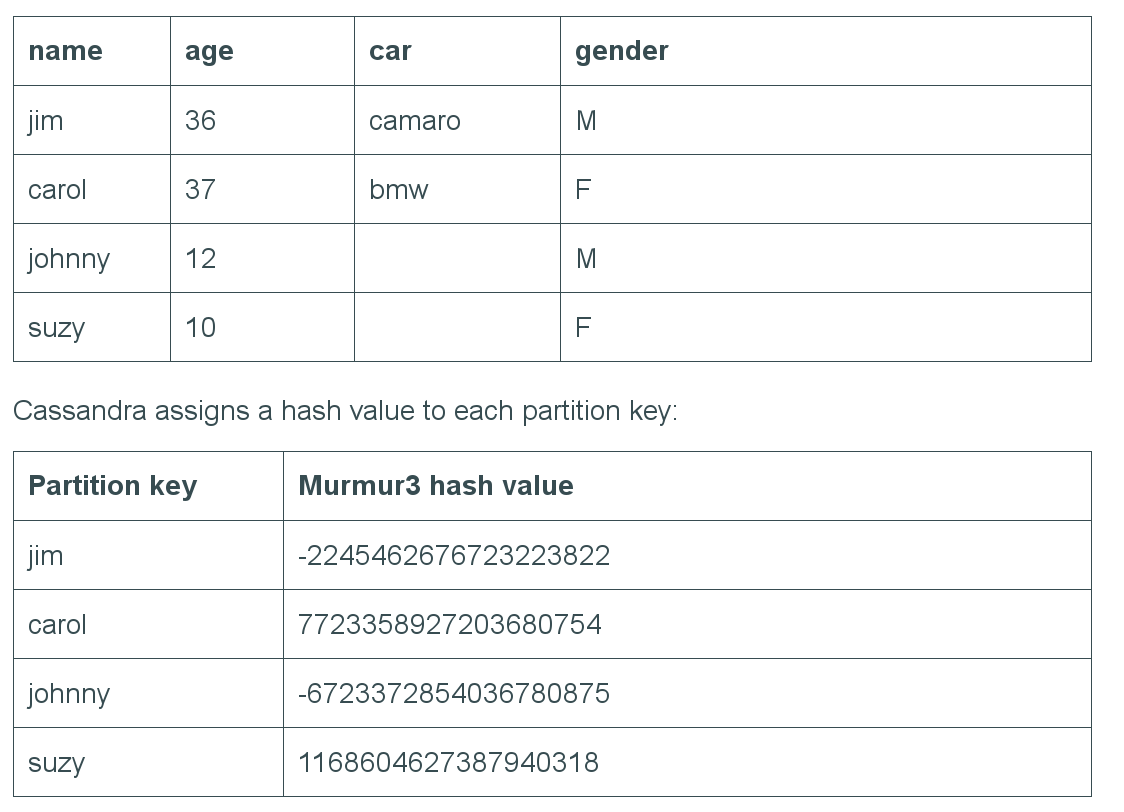
Consistent Hashing: mapping
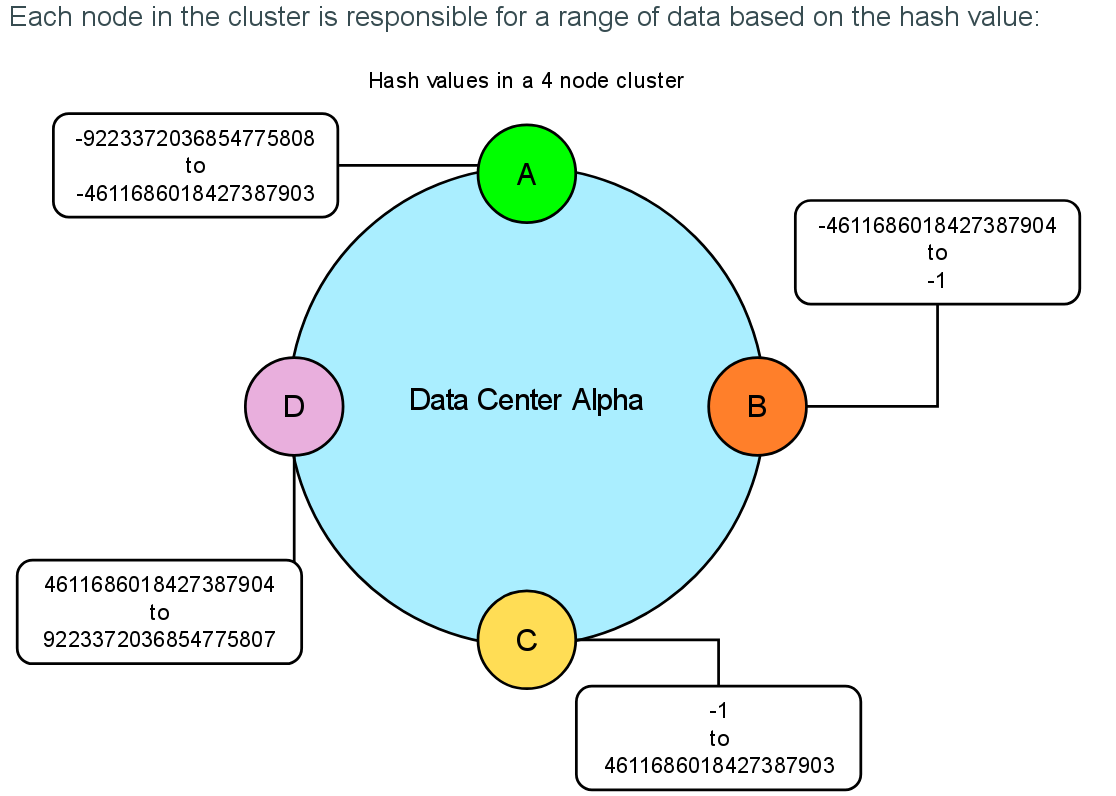
Consistent Hashing: mapping
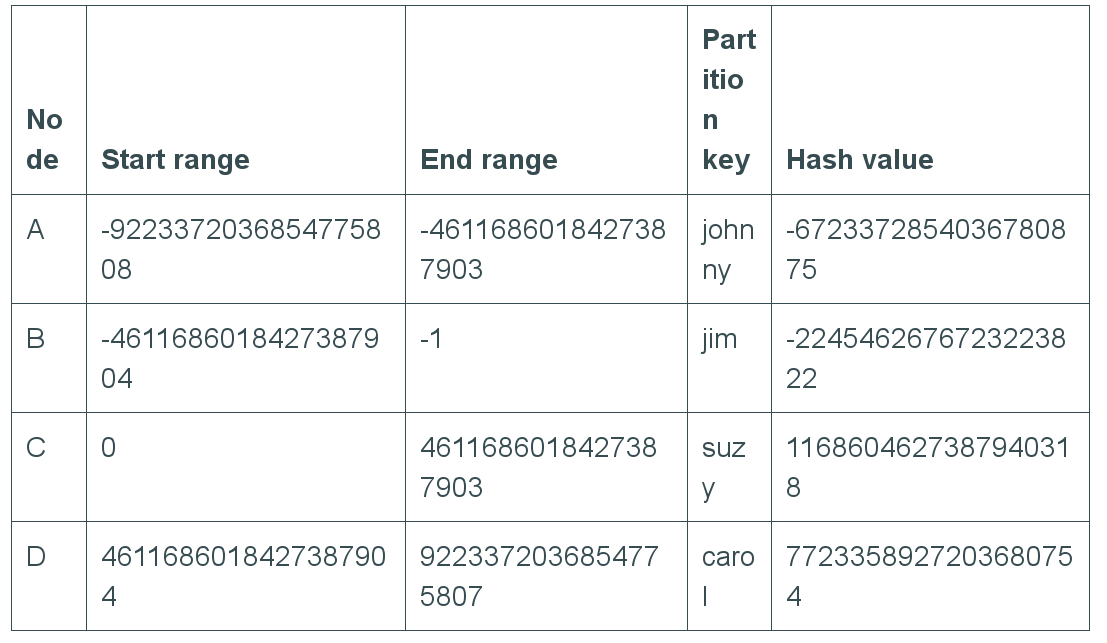
Data Replication
Create copies of the data, thus avoiding a single point of failure.
Replication Factor (RF) = # of replica for each data
set at the Keyspace level
Topology informations: Snitches
Inform the database about the network topology
⇒ requests are routed efficiently
⇒ support replication by groupping nodes (racks/datacenters) and avoid correlated failures
SimpleSnitch ⇒ does not recognize datacenter or rack information
RackInferringSnitch ⇒ infers racks and DC information
PropertyFileSnitch ⇒ uses pre-configured rack/DC informations
DynamicSnitch ⇒ monitor read latencies to avoid reading from hosts that have slowed down
Replication strategies
use proximity information provided by snitches to determine locality of a copy
SimpleStrategy:
use only for a single data center and one rack
place the copy to the next available node (clockwise)
NetworkTopologyStrategy: specifies how many replicas you want in each DC
defined at keyspace level
Replication strategies
CREATE KEYSPACE lesfurets
WITH replication =
{'class': 'NetworkTopologyStrategy', 'RBX': 2,'GRV':2,'LF':1};SimpleReplicationStrategy
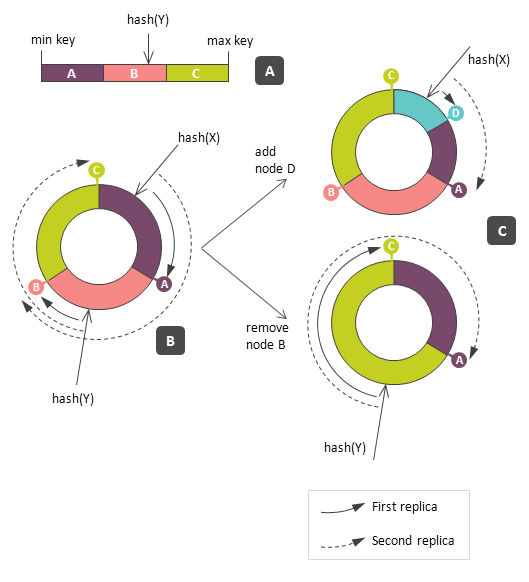
NetworkTopologyStrategy
CREATE KEYSPACE lesfurets
WITH replication =
{'class': 'NetworkTopologyStrategy', 'RBX': 2,'GRV':2,'LF':1};
Token allocation
static allocation (initial-token="-29334…" dans cassandra.yaml)
need to be modified at each topology change
VNODES ( num_tokens )
random slot allocation (< 3.0)
Virtual nodes (VNodes)

VNodes: remapping keys
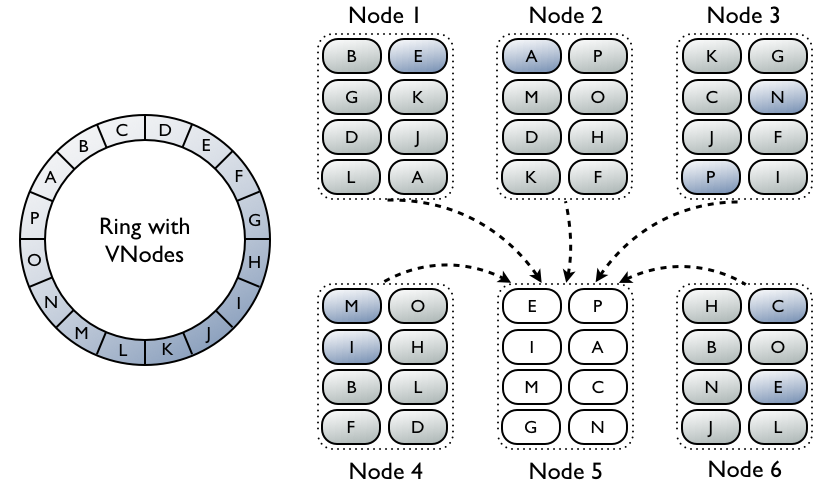
VNodes: heteregenous clusters

Plan
Motivation
Apache Cassandra
Partitioning and replication
Consistency
Practice: Tune consistency in Apache Cassandra
Properties of distributed systems
Consistency: read is guaranteed to return the most recent write for a given client.
Availability: non-failing node will return a reasonable response within a reasonable amount of time (no error or timeout)
Partition Tolerance: the system will continue to function when network partitions occur.
Consistency
a read returns the most recent write
eventually consistent : guarantee that the system will evolve in a consistent state
provided there are no new updates, all nodes/replicas will eventually return the last updated value (~DNS)

Availability
a non-failing node will return a reasonable response (no error or timeout)

Partition tolerance
ability to function (return a response, error, timeout) when network partitions occur

Partition tolerance
network is unreliable
you can choose how to handle errors
return an old value
wait and eventually timeout, or return an error at once
in practice: choice between AP and CP systems
CAP theorem
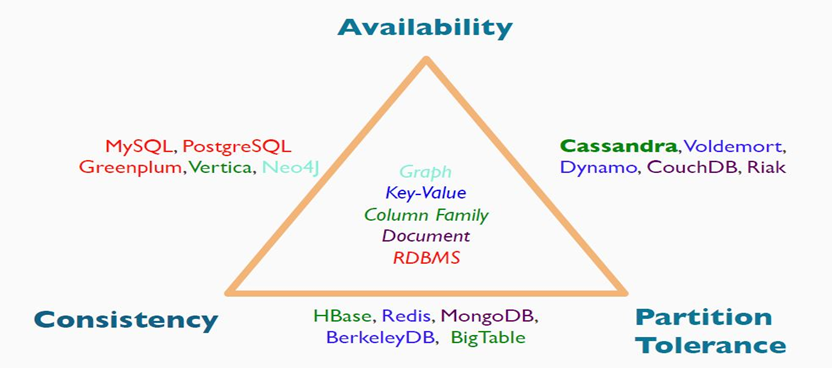
BASE
RDBMS: Atomic, Consistent, Isolated, Durable
Cassandra: Basically Available, Soft state, Eventually consistent
Cassandra consistency
AP system
eventually consistent
without updates the system will converge to a consistent state due to repairs
tunable consistency :
Users can determine the consistency level by tuning it during read and write operations.
Consistency Level (CL)
mandatory protocol-level parameter for each query (read/write),
#replicas in a cluster that must acknowledge the read / write
write consistency - R: #replicas on which the write must succeed* before returning an acknowledgment to the client application.
read consistency - W: #replicas that must respond to a read request before returning data to the client application
default level: ONE
most used: ONE, QUORUM, ALL, ANY … (LOCAL_ONE, LOCAL_QUORUM…)
Which consistency level ?
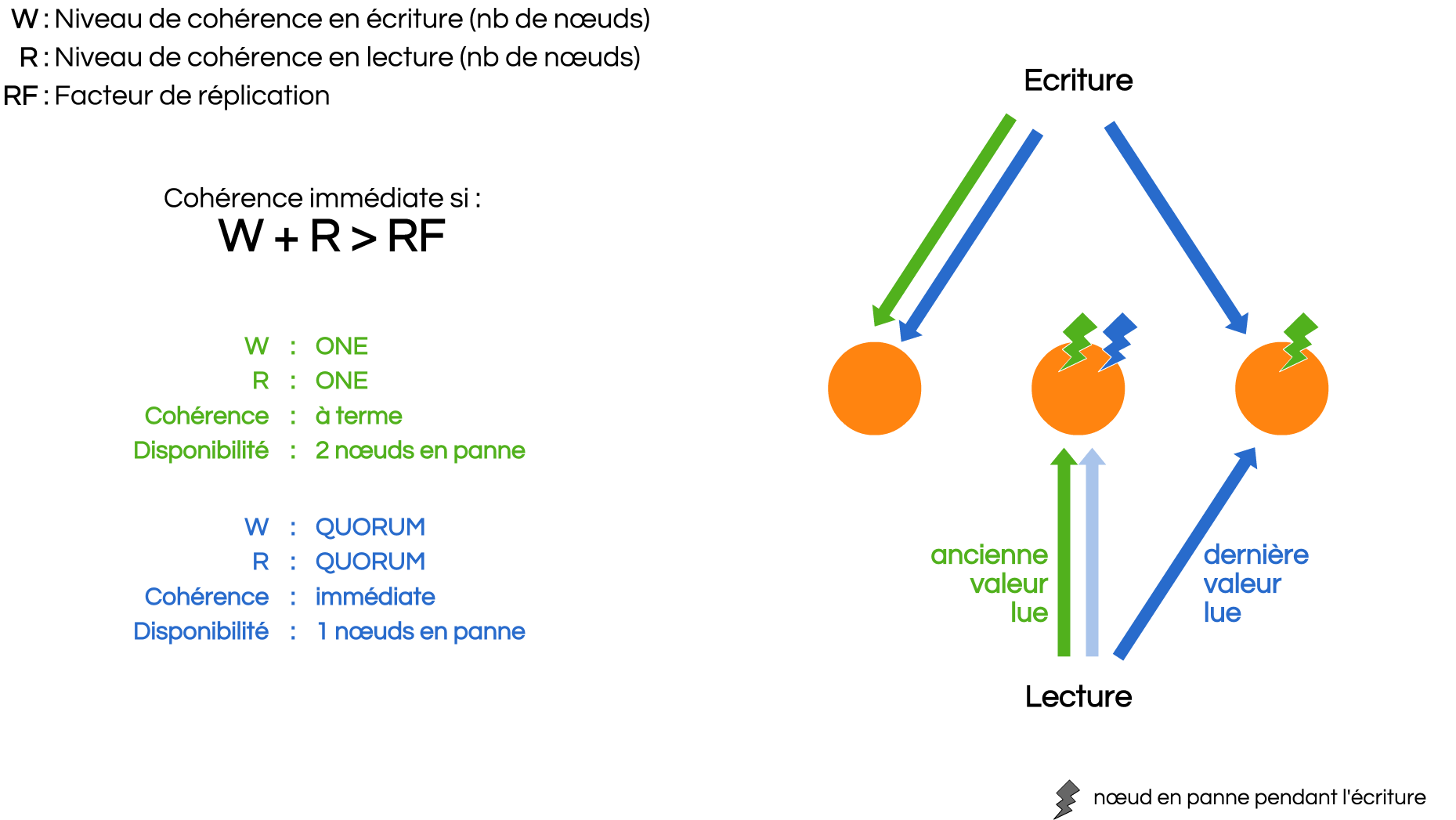
Consistency mechanisms
writes ⇒ hinted handoff
reads ⇒ read repairs
maintenance ⇒ anti-entropy repair (nodetool repair)
Hinted handoff
ONE/QUORUM vs ANY (any node may ACK even if not a replica)
if one/more replica(s) are down ⇒ hinted handoff

Read repairs
Goal: detect and fix inconsistencies during reads
CL = ONE ⇒ no data is repaired because no comparison takes place
CL > ONE ⇒ repair participating replica nodes in the foreground before the data is returned to the client.
send a direct read request to a chosen node that contains the data (fastest responding)
send digest requests to other replicas
if digest does not agree send direct request to replicas and determine the latest data (column level!)
writes the most recent version to any replica node that does not have it
return the data to the client
Read repairs ONE
Read repairs QUORUM
Read repairs QUORUM DC
Anti-entropy repair (nodetool repair)
for each token range, read and synchronize the rows
to insure the consistency this tool must be run regularly !
nodetool repair [options] [<keyspace_name> <table1> <table2>]
nodetool repair --fullmanual operation, must be scheduled ! (Cassandra Reaper, Datastax)
Durability
guarantees that writes, once completed, will survive permanently
appending writes to a commitlog first
default: flushed to disk every commitlog_sync_period_in_ms
batch mode ⇒ sync before ACK the write
Cassandra write path

Cassandra compactions
collects all versions of each unique row
assembles one complete row (up-to-date)
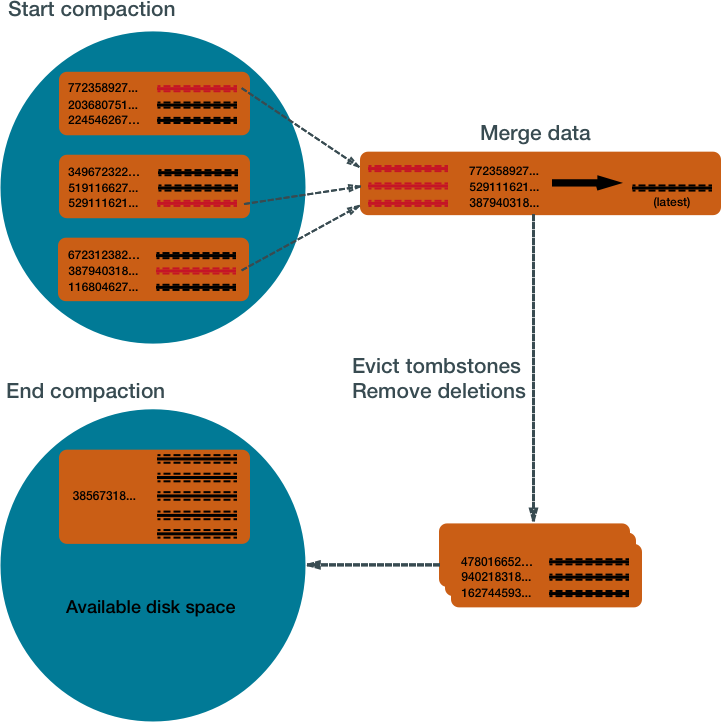
Cassandra read path (caches)

Cassandra read path (disk)
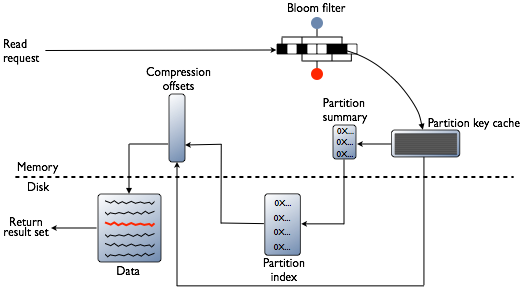
More info
Plan
Motivation
Apache Cassandra
Partitioning and replication
Consistency
Practice: Tune consistency in Apache Cassandra
Practice: Tune consistency in Apache Cassandra
create local test clusters
explore configuration options and consistency properties
Cassandra cluster manager
create multi-node cassandra clusters on the local machine
great for quickly setting up clusters for development and testing
$ccm create test -v 2.0.5 -n 3 -s (1)
$ccm node1 stop (2)
$ccm node1 cqlsh (3)Nodetool
a command line interface for managing a cluster
explore, debug, performance test
maintenance operations, repairs
$ccm node1 nodetool status mykeyspace (1)
Datacenter: datacenter1
========================
Status=Up/Down
|/ State=Normal/Leaving/Joining/Moving
-- Address Load Tokens Owns Host ID Rack
UN 127.0.0.1 47.66 KB 1 33.3% aaa1b7c1-6049-4a08-ad3e-3697a0e30e10 rack1
UN 127.0.0.2 47.67 KB 1 33.3% 1848c369-4306-4874-afdf-5c1e95b8732e rack1
UN 127.0.0.3 47.67 KB 1 33.3% 49578bf1-728f-438d-b1c1-d8dd644b6f7f rack1CQLSh
standard CQL client
[bigdata@bigdata ~]$ ccm node2 cqlsh (1)
Connected to test at 127.0.0.2:9160.
[cqlsh 4.1.1 | Cassandra 2.0.5-SNAPSHOT | CQL spec 3.1.1 | Thrift protocol 19.39.0]
Use HELP for help.
cqlsh> SELECT * FROM system.schema_keyspaces ; (2)VSCODE plugin
